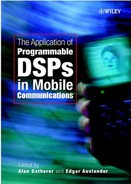Book Description
With the introduction of WAP in Europe and I-mode in Japan, mobile terminals took their first steps out of the world of mobile telephony and into the world of mobile data. At the same time, the shift from 2nd generation to 3rd generation cellular technology has increased the potential data rate available to mobile users by tenfold as well as shifting data transport from circuit switched to packet data. These fundamental shifts in nature and the quantity of data available to mobile users has led to an explosion in the number of applications being developed for future digital terminal devices. Though these applications are diverse they share a common need for complex Digital Signal Processing (DSP) and in most cases benefit from the use of programmable DSPs (Digital Signal Processors).
* Features contributions from experts who discuss the implementation and applications of programmable DSPs
* Includes detailed introductions to speech coding, speech recognition, video and audio compression, biometric identification and their application for mobile communications devices
* Discusses the alternative DSP technology which is attempting to unseat the programmable DSP from the heart of tomorrow's mobile terminals
* Presents innovative new applications that are waiting to be discovered in the unique environment created when mobility meets signal processing
The Application of Programmable DSPs in Mobile Communications provides an excellent overview for engineers moving into the area of mobile communications or entrepreneurs looking to understand state of the art in mobile terminals. It is also a must for students and professors looking for new application areas where DSP technology is being applied.
Table of Contents
- Cover Page
- Title Page
- Copyright
- Contents
- Biographies
- List of Contributors
- 1: Introduction
- 2: The History of DSP Based Architectures in Second Generation Cellular Handsets
- 3: The Role of Programmable DSPs in Dual Mode (2G and 3G) Handsets
- 3.1 Introduction
- 3.2 The Wireless Standards
- 3.3 A generic FDD DS Digital Baseband (DBB) – Functional View
- 3.4 Functional Description of a Dual-Mode System
- 3.5 Complexity Analysis and HW/SW Partitioning
- 3.6 Hardware Design Approaches
- 3.7 Software Processing and Interface with Higher Layers
- 3.8 Summary
- 3.9 Abbreviations
- References
- 4: Programmable DSPs for 3G Base Station Modems
- 5: The Use of Programmable DSPs in Antenna Array Processing
- 6: The Challenges of Software-Defined Radio
- 7: Enabling Multimedia Applications in 2.5G and 3G Wireless Terminals: Challenges and Solutions
- 8: A Flexible Distributed Java Environment for Wireless PDA Architectures Based on DSP Technology
- 9: Speech Coding Standards in Mobile Communications
- 10: Speech Recognition Solutions for Wireless Devices
- 11: Video and Audio Coding for Mobile Applications
- 12: Security Paradigm for Mobile Terminals
- 13: Biometric Systems Applied To Mobile Communications
- 14: The Role of Programmable DSPs in Digital Radio
- 15: Benchmarking DSP Architectures for Low Power Applications
- 16: Low Power Sensor Networks
- 17: The Pleiades Architecture
- 17.1 Goals and General Approach
- 17.2 The Pleiades Platform – The Architecture Template
- 17.3 The Control Processor
- 17.4 Satellite Processors
- 17.5 Communication Network
- 17.6 Reconfiguration
- 17.7 Distributed Data-Driven Control
- 17.8 The Pleiades Design Methodology
- 17.9 The P1 Prototype
- 17.10 The Maia Processor
- 17.11 Summary
- References
- 18: Application Specific Instruction Set Architecture Extensions for DSPs
- 19: The Pointing Wireless Device for Delivery of Location Based Applications
- 19.1 Next Generation Wireless Devices
- 19.2 The Platform
- 19.3 New Multimedia Applications
- 19.4 Location Based Information
- 19.5 Using Devices to Summon Information
- 19.6 Pointing to the Real World
- 19.7 Pointing Greatly Simplifies the User Interface
- 19.8 Uses of Pointing
- 19.9 Software Architecture
- 19.10 Use of the DSP in the Pointing System
- 19.11 Pointing Enhanced Location Applications
- 19.12 Benefits of Pointing
- 19.13 Recommended Data Standardization
- 19.14 Conclusion
- Index
